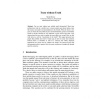Free Online Productivity Tools
i2Speak
i2Symbol
i2OCR
iTex2Img
iWeb2Print
iWeb2Shot
i2Type
iPdf2Split
iPdf2Merge
i2Bopomofo
i2Arabic
i2Style
i2Image
i2PDF
iLatex2Rtf
Sci2ools
PST
2008
2008
The Uncertainty of the Truth
Can we trust without any reliable truth information? Most trust architectures work in a similar way: a trustor makes some observations, rates the trustee, and makes recommendations to his friends. When he faces a new case, he checks his trust table and uses recommendations given by trustworthy friends to decide whether he will undertake a given action. But what if the observations that are used to update the trust tables are wrong? How to deal with what we call the "uncertainty of the truth"? This paper presents how people that publish and remove virtual tags are able to create trust relations between them. A simulator as well as a concrete and widely deployed application have been used to validate our model. We observed good and encouraging results in general, but also some weaknesses, brought out through specific scenarios.
| Added | 30 Oct 2010 |
| Updated | 30 Oct 2010 |
| Type | Conference |
| Year | 2008 |
| Where | PST |
| Authors | Michel Deriaz |
Comments (0)

